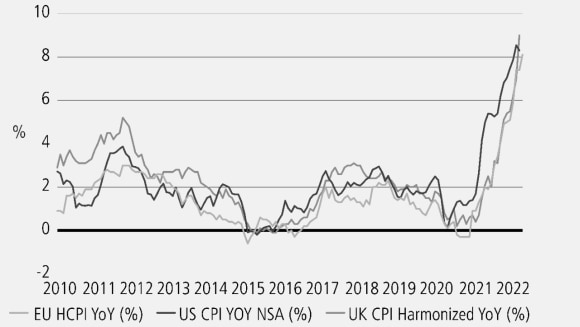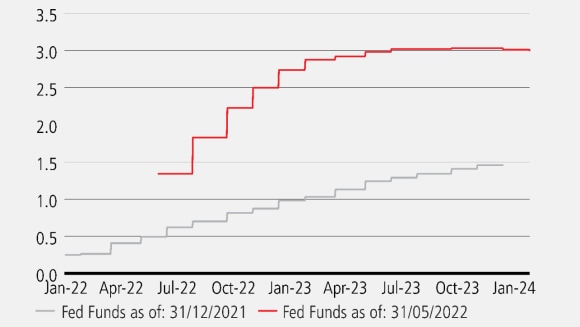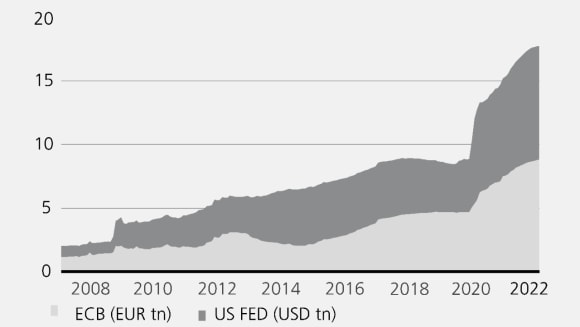Fixed income markets and the end of the ‘Fed Put’
The era of extraordinary monetary policy accommodation, known as “the Fed put”, is over. With inflation at multi-decade highs and central banks raising rates, what does this mean for fixed income investors?
Key highlights
Key highlights
- With governments demonstrating little appetite to tighten fiscal policy through higher taxes or reduced spending, the job of bringing inflation down is resting squarely on the shoulders of central banks.
- This means the era of extraordinary monetary policy accommodation, commonly known as “the Fed put”, is over.
- To avoid 1970s type stagflation, central banks are likely to press ahead with monetary tightening, ensuring that they do not repeat the same mistakes as the late 1960s and 1970s – accepting that it may mean higher unemployment and weaker growth or even recession in the years ahead.
Introduction
Introduction
Inflation in developed markets has recently skyrocketed (chart 1), forcing central banks to abandon the narrative of high inflation being transitory, as they scramble to raise interest rates rapidly. As a result we believe we are likely to be in a new regime of higher interest rates and greater market volatility, signaling an end of the Federal Reserve’s era of extraordinary monetary policy accommodation, commonly known as “the Fed put”.
This policy U-turn has caused bond market panic, with government bond yields rising to the highest levels since 2010 and the stock market falling into a bear market.
Chart 1: Inflation rising rapidly in the US, EU and UK

This is in sharp contrast to the years between the 2008 Global Financial Crisis (GFC) and the COVID-19 outbreak when central banks in most developed countries were still battling against persistent low inflation caused by an ageing population, globalization and advances in information technology. Initially, most economists dismissed the high inflation figures as temporary, largely due to the outsized Biden fiscal stimulus and supply chain disruption caused by COVID-19 lockdowns. Under the traditional Keynesian macro framework, this combination of economic slack and record high inflation is mutually exclusive and should NOT have existed.

Related
Fixed income investments
Fixed income investments
Globally oriented choices for a globally integrated world
Today’s high inflation versus 1970s stagflation
Today’s high inflation versus 1970s stagflation
Over the past 40 years, most economic models assume that when growth is weak, inflation is unlikely to be a problem. The recent high inflation has shocked major central banks out of their long-term complacency as inflation has evidently far surpassed their 2% target, making it foolish to continue calling it transitory or temporary. But are we seeing a repeat of the 1970s stagflation environment?
Previous economic eras can shed some light. How did the world “suddenly” move from a golden era of strong growth and low inflation of the 1950s and 1960s to the stagflation era of the 1970s? According to the authoritative research from economist Barry Eichengreen, the hyperinflation of the 1970s started well before the collapse of Bretton Woods in 1971 – the system of pegging the US dollar to gold – and the OPEC oil embargo in 1973. Inflation was already approaching 6% in 1970.
The causes of rising inflation from 1965 to 1970 were driven by President Lyndon Johnson’s “Great Society”, the fiscal expansion to finance the Vietnam War and most critically a lax monetary policy under Arthur Burns, the then-chair of the Fed. At that time, the Fed did not have a coherent theory connecting monetary policy with inflation as Burns famously said “monetary policy does not matter, inflation was caused by unions’ excessive wage demand, price increases by firms, poor harvest, high oil prices and excessive government spending” - in fact anything but monetary policy.
Coming back to today’s world, the US pumped USD 5.2 trillion into the economy as fiscal relief to combat the impact of the COVID-19 pandemic. The world has also experienced a sharp rise in commodity prices caused by the Russian invasion of Ukraine - though still overshadowed by the price rise during the 1973 OPEC oil embargo. In addition, we are also experiencing policy shifts away from maximizing economic output towards anti-trade policies such as Trump’s tariff on China, anti-immigration policies (Brexit and Trump’s border wall), sanctions on Russia and deglobalization in general.
The most crucial difference between today and the 1970s is that major central banks have adopted a target for low and stable inflation and so far inflation expectations remain well anchored. Milton Friedman famously declared “Inflation is always and everywhere a monetary phenomenon”. Central banks now understand the clear link between monetary policy and inflation and have adopted a coherent policy framework that aims to achieve stable inflation over the medium term, which has been well understood and believed by financial markets, consumers and firms.
To avoid the 1970s type stagflation, therefore, central banks must press ahead with monetary tightening to combat this 40-year high inflation, ensuring that they do not repeat the same mistakes as the late 1960s and 1970s – accepting that it may mean higher unemployment and weaker growth or even recession in the years ahead.
Changing political winds
Changing political winds
We argued earlier that a sudden jump in inflation may coincide with a major war or an external shock like the COVID-19 pandemic. But the underlying causes can be traced to the changes in political preference and economic policies in the preceding years, similar to what had happened before the 1970s’ hyperinflation, according to Eichengreen.
Inflation is caused by too much money chasing too few goods or services. Governments across the developed world typically handed citizens more money, as seen in the US through the Trump and Biden stimulus cheques or the furlough scheme in the UK. Meanwhile, supplies were limited by lockdowns, factory closures, long shipping delays, and people dropping out of the labor force. High inflation inevitably followed.
Because those in charge of governments in all major countries now show little appetite to tighten fiscal policy through higher taxes or reduced government spending, the job of bringing inflation down is squarely resting on the shoulders of central banks alone. Now, inflation is obviously too high and not transitory, giving central banks no other choice but to tighten monetary policy.
After winning their battle on inflation over the past 40 years, major central banks like the Fed and European Central Bank are unlikely to tolerate high inflation for too long (Chart 2). In addition, central banks cannot stop the war in Ukraine nor can they solve the supply chain problems. Their major tool is to reduce demand by tightening monetary policy, which means higher real rates and less liquidity by shrinking their bloated balance sheets (Chart 3). Individuals, companies, and governments who had borrowed a lot on low rates will feel the squeeze, with major pain likely in the years ahead.
Chart 2: US rate expectations

Chart 3: US Fed and ECB balance sheets expected to shrink

Therefore, we believe that a repeat of the 1970s stagflation is highly unlikely as central banks, having learnt their lessons, now have a coherent monetary policy framework and determination to fight inflation. Unfortunately, there is no free lunch from this monetary tightening cycle. The Bank of England has already sounded the alarm bell that further rate increases may tip the UK into recession by the end of this year while the Fed still optimistically wants people to believe its tightening will not cause a recession. Given the change in politics towards ‘levelling up’ for low to middle income earners, we should expect a shift away from free trade, further restrictions on immigration and a more restrained version of globalization or even deglobalization that will force inflation higher than the decade following the 2008 Global Financial Crisis. At the same time, growth and productivity are likely to fall.
Implications for fixed income investors
Implications for fixed income investors
This apparent end of low inflation has probably spelled the end of the 40-year bull market in bonds. High inflation will likely force central banks to run tighter monetary policy for longer and become more reluctant to cut rates early regardless of recession risks.
Although high inflation is not good for consumers, central banks or existing bond holders, it still has a silver lining. Bond investors may now obtain a good level of income from holding bonds purchased at this time, and we believe the uncertainties in policy and inflation outlook may create good opportunities for active bond managers to add value by anticipating regime change and relative values across countries and different asset classes. When central banks have to balance weak growth against controlling high inflation, they are more likely to make policy mistakes.
For bond markets in the near term, there is a risk that some investors will buy now as they believe weaker growth and falling stock markets will soon force major central banks to make a U-turn as the Fed did from the end of 2018. In contrast, our focus will be on inflation developments in the next six-to-12 months rather than growth weakening or stock market weakness before we turn strategically bullish on duration in this tightening cycle. Higher real yields, weak growth and a reduction in liquidity all call for a cautious, nimble and selective stance in credit.
In the past we always stated that real yields needed to stay low when central banks had struggled to achieve their inflation target on the upside. Now policymakers have the opposite problem, and as a result we believe we have left the era of extraordinary monetary policy accommodation, commonly known as the ‘Fed put’, and entered a new regime of higher interest rates and greater market volatility.

PDF
Mid-year outlook 2022
Mid-year outlook 2022
With inflation reaching multi-decade highs in many parts of the world, how can investors position their portfolios for this changing investment landscape?
Was this article helpful?
Please enable javascript in your browser and retry.
The feedback component cannot be displayed.
About the author

Kevin Zhao
Head of Global Sovereign & Currency
Kevin Zhao is the lead portfolio manager on all active Global Sovereign and Flexible Fixed Income Strategies as well as Active Currency Management. In this role he is responsible for all investment decisions taken for and implemented in these strategies. He is a member of the Fixed Income Investment Forum.
Read more
Make an inquiry
Fill in an inquiry form and leave your details – we’ll be back in touch.
Introducing our leadership team
Meet the members of the team responsible for UBS Asset Management’s strategic direction.


